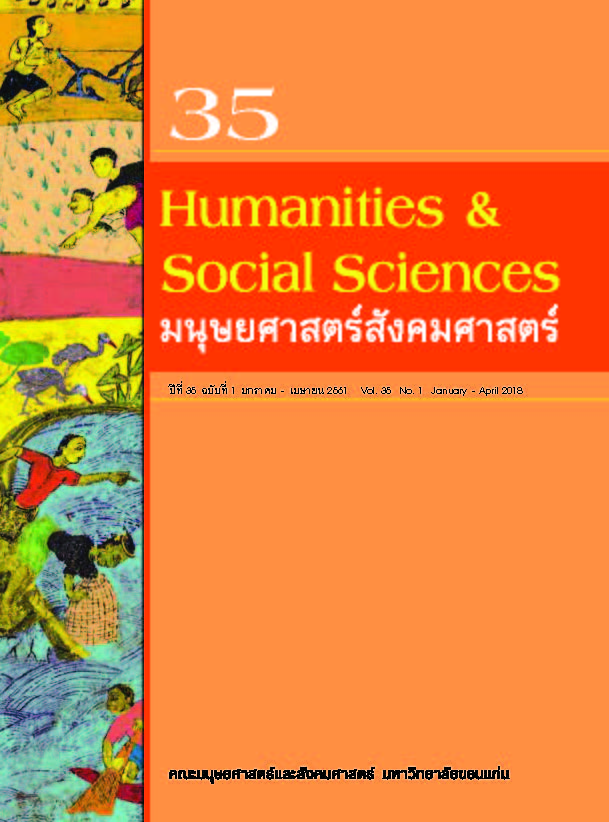การเปรียบเทียบความหมายระหว่างอักษรคันจิของญี่ปุ่นและอักษรจีน
Abstract
บทคัดย่อ
บทความนี้มีวัตถุประสงค์ เพื่อเปรียบเทียบความหมายของอักษรคันจิของญี่ปุ่นและอักษรจีน โดยเลือกเฉพาะคู่อักษรคันจิของญี่ปุ่นและอักษรจีนแบบย่อที่มีรูปคำเหมือนกัน และยึดความหมายของอักษรคันจิเป็นหลัก อักษรคันจิของญี่ปุ่น 98 อักษรมาจากหนังสือ初級日本語 : Shokyuu Nihongo และนำความหมายที่รวบรวมไว้ในพจนานุกรมไทย-จีน โดยเธียรชัย เอี่ยมวรเมธ(2551) และพจนานุกรมKodansha’s Compact Kanji Guide ฉบับภาษาไทย(2545)มาเป็นหลักในการเปรียบเทียบ
ผลการศึกษาพบว่า จากการเทียบความหมายในพจนนุกรม แบ่งได้เป็น 3 ลักษณะคือ ความตรงกัน ความหมายต่าง และความหมายที่อักษรจีนมีความหมายกว้างกว่าอักษรคันจิของญี่ปุ่น อักษรที่มีความหมายตรงกันมีจำนวน 6 คู่ คิดเป็นร้อยละ 6.12 อักษรที่มีความหมายต่างมีจำนวน 1 คู่ คิดเป็นร้อยละ 1.02 และอักษรจีนที่มีความหมายกว้างกว่ามีจำนวน 91 คู่ คิดเป็นร้อยละ 92.86 ในคู่อักษรจีนที่มีความหมายกว้างกว่าอักษรคันจิของญี่ปุ่น สามารถแบ่งได้ 2 ด้าน คือ ด้านความหมายและด้านการใช้ ด้านความหมาย แบ่งเป็น 3 ประเภท ได้แก่ 1. ความหมายขยายออก มี 59 คู่ เป็นประเภทที่มีจำนวนอักษรมากที่สุด 2. ความหมายตามสังคม 25 คู่ 3. ความหมายตามประวัติศาสตร์ 5 คู่ ด้านการใช้ แบ่งเป็น 4 ประเภท ได้แก่ 1. การใช้เป็นนามสกุล 54 คู่ 2. การใช้เป็นสัญลักษณ์ 28 คู่ 3. การนำมาใช้เป็นคำทางไวยากรณ์ 21 คู่ และ 4. การนำมาใช้เป็นความหมายเฉพาะ 3 คู่ โดยที่อักษรจีนหนึ่งอักษรนั้น จะสามารถจัดประเภททางความหมายได้มากกว่าหนึ่งประเภท เนื่องจากอักษรจีนหนึ่งอักษรมีความหมายมากกว่าหนึ่งความหมาย เห็นได้ว่าอักษรจีนมีความหมายขยายออกไปตามบริบทสังคมและวัฒนธรรม ทำให้อักษรจีนมีความหมายกว้างกว่าอักษรคันจิในภาษาญี่ปุ่น
คำสำคัญ : อักษรจีน; อักษรคันจิ; ความหมาย; ความหมายกว้างออก
ABSTRACT
The objective of this article is to compare the meaning of kanji characters of Japan and Chinese characters by choosing only the pairs of Japan’s kanji characters and simplified Chinese characters that have similar written forms based primarily on the meanings of the kanji characters. Ninety-eight Japan’s kanji characters are taken from the book entitled
初級日本語: Shokyuu Nihongo and the meanings compiled in Thiarachai Iamworametha’s Thai-Chinese dictionary (2008) and Kodansha’s Compact Kanji Guide in the Thai version (2002) are used for the comparison.
The findings indicate that a comparison of meanings in dictionaries yields three results: same meanings, different meanings, and widened meanings where the meanings of Chinese characters are wider than those of Japan’s Kanji characters. The comparison of meanings of Chinese characters and those of Japan’s Kanji characters shows that there are six pairs, representing 6.12%, having the same meanings, one pair or 1.02% with different meanings, and 91 pairs or 92.86% with widened meanings. With regard to those Chinese characters whose meanings are wider than their Japan’s Kanji counterparts, there are two types of widening: meaning and function. In term of meaning, they can be further classified into three categories: (1) 59 pairs with the widening of meanings, which account for the largest number, (2) 25 pairs that have social meanings, and (3) five pairs that have historical meanings. In term of function, they can be further classified into four categories: (1) 54 pairs that are used as family names, (2) 28 pairs that are used as symbols, (3) 21 pairs that are used as grammatical words, and (4) three pairs that are used for specific meanings. One Chinese character can be classified into more than one category since one Chinese character has more than one meaning. It can be seen that differences in social and cultural contexts cause Chinese characters to have widened meanings; thus, Chinese characters’ meanings are wider than those of Japan’s kanji characters.
Keywords: Chinese character, Kanji character, meaning, widening of meaning



